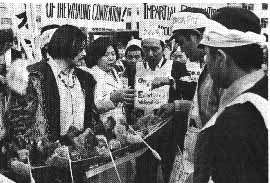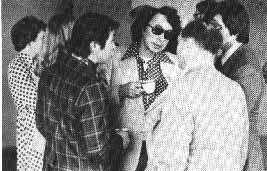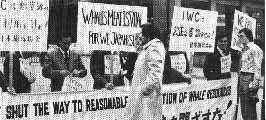(MERRY CHRISTMAS AND A HAPPY NEW YEAR)
NORTH SLOPE BOROUGH, P. O. BOX 69, BARROW ALASKA 99723
TELEPHONE (907) 852-2611
Issue No: Eight______________Part 1_____________Date: December, 1977
FOR IWC SHOWDOWN
NSB STRATEGY TAKES WHALERS TO TOKYO
Earlier NSB impressions were that the Japanese Government wanted to bargain increased sperm whale commercial quotas for a bowhead subsistence quota, and it was not clear that the Inupiat community should have anything to do with the Tokyo meeting. Some felt that Inupiat participation in the Tokyo IWC meeting would amount to de facto recognition of IWC jurisdiction over Inupiat subsistence whaling, especially if commercial quotas were to be traded for subsistence
|
||||
It wasn’t until the last week in November that it was decided that an Alaska Eskimo Whaling Commission delegation should attend the meeting. It was learned that the IWC’s Scientific Committee had met earlier in Australia to reconsider the low North Pacific Sperm Whale quotas set at the regular meeting of the IWC in Australia last June. Apparently the IWC had used biological data from the more depleted South Pacific Sperm Whale population for determining the maximum sustainable yield from the less depleted North Pacific Sperm Whale population, and the result was a quota reduction from 7,000 in 1976-77 to only 763 for 1977-78, a figure that would wipe out the Japanese and Russian Pacific whaling industry. Toward the end of November, it was announced that the IWC’s Scientific Committee had recommended a North Pacific sperm whale quota of 6,444, only a 10% reduction from the 1976 quota.
“Alaska Today” is currently being presented on KHAR in Anchorage Sundays at 9:00 p.m. and is being made available to commercial and regional radio stations. The first four programs are entitled “The Story of Oil in Alaska,” “The Pipeline and Alaska Native Land Claims,” Management and the Alaskan “Energy Development and Small Communities.”
The program is being produced under the direction of Marty Strauss of Advocacy Planning Associates. Mr. Strauss is a former VISTA worker with the Mauneluk Association where he worked as an environmental planner. Stations interested in presenting the program should contact “Alaska Today,” 610 H Street, Anchorage, AK 99501, or call 907/274-2414. “Coastal Zone Village.”
Thus, it was clear that the Tokyo bowhead moratorium negotiations would be far more complex than a matter of swapping quotas.
The NSB had heard that Canada might be a problem in October, and had communications been better between Barrow and Ottawa and the Canadian Arctic, the Inupiat whalers might have enjoyed Canada’s support in Tokyo. NSB officials heard in mid-November that the Canadian government was conferring with ITC about its bowhead subsistence policy, but there was no consultation between ITC and Barrow over the matter.
When the 12-person AEWC delegation caught the Northwest Orient Airlines 747 to Tokyo, William Aron and other members of the U.S. delegation were on board and expressed concern to the Inupiat whalers that there might be trouble getting the necessary 3/4 vote to establish a new bowhead quota. He said that Canada, France, New Zealand and Australia were likely to oppose the U.S. position on the restoration of the bowhead subsistence hunt.
|
|
Arriving in Tokyo after delays caused by mechanical problems with the aircraft in Anchorage, the delegation had three days over the weekend to get the lay of the land and politic with the various IWC delegations. A special surprise was the arrival of Sam Raddi and Randy Pokiak from the Canadian Inuvialuits’ Committee on Original Peoples Entitlement (COPE). Both Raddi and his associate Poknak were added to the Canadian IWC delegation at the last minute when Bob Delury, Canadian Arctic Resources Committee, notified Raddi that the Canadian government was planning to oppose the U.S. position, and in any event would have no Inuit delegates to the IWC. With less than 48 hours notice, Raddi pressured the Canadian government to add him and Pokiak to the Canadian delegation so that he could work to seek Canadian support of Inupiat subsistence whaling rights.
Raddi’s presence in Tokyo was good news, and provided the Inupiat whalers with insight into the politics of the Canadian delegation. Raddi’s success in coming to Tokyo to help defend subsistence whaling was in contrast to that of the Greenlandic Inuit. In late November, Hopson had telexed Denmark’s Greenland Minister in Copenhagen requesting that the Danes send either Moses Olsen or Angalamortug Olsen with Danish IWC Commissioner Einar Lehmke. According to Lehmke, the Greenland Ministry queried the Greenland Provincial Council with this request, but the Land Council did not send a Greenlander to Tokyo. NSB


